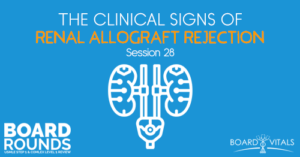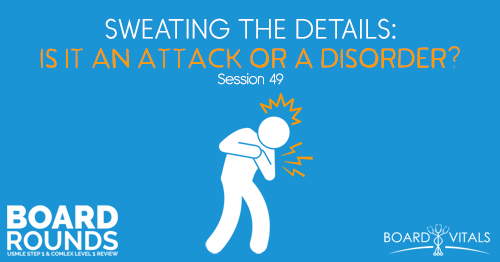Apple Podcasts | Google Podcasts

Session 28
A patient with a 2-month-old kidney transplant has elevated creatinine, fever, and tenderness at the graft region. What other finding is likely present?
As always, we’re joined by Dr. Karen Shackelford of BoardVitals as we dig into today’s case to help give you a better understanding.
Listen to this podcast episode with the player above, or keep reading for the highlights and takeaway points.
[01:02] BoardVitals
If you’re preparing for your USMLE Step 1 or COMLEX Level 1, check out how BoardVitals can help you prepare for your exam. Use the promo code BOARDROUNDS to save 15% off their QBanks. They have the 3-month version with over 1,700 questions. Once you’re in medical school, they also have QBanks for the SHELF exams.
[02:24] Question of the Week
The patient who has a history of kidney failure as a result of multicystic kidneys has an allograft kidney transplant. Two months later, she presents with fever, malaise, and tenderness in the graft region. Her lab work shows a rise in creatinine. What other finding is characteristic of her condition?
(A) Hypotension
(B) Decreased graft size on the ultrasound
(C) Patchy mononuclear cell infiltrates without tubulitis
(D) Urinary obstruction
(E) Oliguria
[03:20] Thought Process
The correct answer is E. The oliguria is a frequent finding. She has fever, malaise, and graft tenderness. Some patients can actually be asymptomatic during acute renal transplant rejection. They usually have hypertension that’s why answer choice A is wrong. The graft may actually be enlarged on ultrasound. Creatinine only rises when there’s significant histologic damage. If the graft rejection progressed, there would be weakness and fibrosis. You would have a decreased graft size but not at this point.
Patchy mononuclear cell infiltrates without tubulitis is a pathological description of something that occurs in patients who have a normal functional renal allopath. So the histopathological findings in patients with rejection may have findings of interstitial infiltration with mononuclear cells, sometimes eosinophils. And the tubular basement membrane will be disrupted by these infiltrating cells. This is tubulitis.
Along with inch-small arteritis, it’s considered the primary lesion of acute cellular rejection. Acute antibody-mediated rejection is characterized by vasculitis with neutrophils, anti-glomerular and peritubular capillaries fibrin, thrombi, or nephrosis. Then there’s interstitial hemorrhage, the presence of CD4 and antibody-specific to the donor suggest an antibody-mediated reaction.
In chronic allograft dysfunction, you will see peritubular basement membrane splitting and multi-layering of the basement membrane.
The antibody-mediated rejection is an albumin response that occurs as antigen-antibody complex fixes complement with the activation of multiple complement protein. C4D is the component of the normal complement pathway. When C4 is split into C4A and C4B, C4B is then converted to C4D. This binds covalently to the endothelial basement membrane and the collagen basement membrane.
In a normal kidney, C4D can be found in the glomerular mesangium and at the vascular pole. But the excessive reduction of immune complex deposition disease results in accumulation in the glomerular capillaries. The CD4 deposition can be seen by monoclonal antibodies staining and fluorescent tissue immunofluorescence.
Peritubular capillaries staining is useful in just renal allografts. In acute allogra rejection graft, they appear large. Urinary obstruction is not the mechanism of oliguria in patients with renal allograft rejection.
[09:20] Definition of Acute Rejection
Graft versus host reaction is an immune condition that occurs immediately after a transplant procedure when the immune cells from the donor attack the recipient patient’s host tissue.
Acute rejection goes the other direction that is characterized by oliguria, fever, malaise, and graft tenderness. So you’re having this inflammatory reaction. When you have chronic rejection, like anything else she developed, there was significant tissue damage from chronic inflammation.
The most common cause of graft failure after the first year is called chronic rejection under the Banff classification system. Chronic allograft nephropathy, which is chronic rejection, is characterized by interstitial fibrosis and tubular atrophy.
Links:
BoardVitals (Use the promo code BOARDROUNDS to save 15% off their QBanks.)
SEARCH SITE
LISTEN FOR FREE











